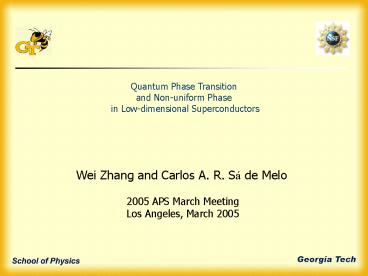Quantum Phase Transition - PowerPoint PPT Presentation
1 / 18
Title: Quantum Phase Transition
1
Quantum Phase Transition and Non-uniform Phase
in Low-dimensional Superconductors
Wei Zhang and Carlos A. R. Sá de Melo
2005 APS March Meeting Los Angeles, March 2005
2
Magnetic Order V.S. Superconductivity
Copper Oxides
Mutually exclude? OR Coexist?
Strontium Ruthenate
Ferromagnetic Superconductors
Organic Superconductors
Coexisting, inhomogeneous, striped phase
3
Phase Diagram of (TMTSF)2PF6
D. Jérome, et al., Mol. Cryst. Liq. Cryst. 79,
155 (1982).
?
T. Vuletic, et al., Eur.Phys.J. B 25, 319 (2002)
4
Upper Critical Magnetic Field
- Hc2 can reach as large as 1.0T
- Hc2 shows upper curvature behavior from 0.3T
I.J. Lee, et al., Phys. Rev. Lett. 88, 207002
(2002).
5
Proposed AF-TS Coexistence Region
- Coexisting phase is inhomogeneous and can
- exist in a narrow range of pressures.
- Stripe pattern is formed in that region.
6
Quasi 1-D System
S
Dc
(Da)
- Spin density wave order parameter S
- Triplet superconductivity order parameter D
?
At low field
7
Ginzburg-Landau Free Energy
- TS State
- Typical GL free energy
- Extra terms in expansion, which are relevant
away from critical point
- AF State Analogous
8
Ginzburg-Landau Free Energy (Contd)
- Interface coupling energy
- If , approximate order
parameters by linear functions,
Where .
9
Ginzburg-Landau Free Energy (Contd)
Positive interface energy
Negative interface energy
Macroscopically exclude
Coexist
Bulk phase
Stripe phase
10
Continuous Phase Transition
Exponents
Dimensionless parameters
11
Microscopic Description
where
TS
AF
Auxiliary field
TS
AF
12
Expansion around critical temperature
- Quadratic Term
- Quartic Term
13
Coupling Term in S4
- Consider anisotropy of the system
AF
TS
- In real space
Negative or Positive coupling energy
Negative or Positive
14
Conclusions
- Coexistence region of AF and TS phases is
proposed under the existence of negative AF-TS
coupling.
- The intermediate phase is inhomogeneous and
consists of alternating AF and TS stripes.
15
Future Topics
- Conditions for the negative AF-TS coupling
- Calculate other G-L parameters
- Stripe Pattern
Magnetic field
16
Simultaneous NMR and Resistance Measurements
Resistance Measurement Superconducting phase
onsets for different H
NMR Measurement Proton spin-lattice relaxation
time and local field (believed characterized SDW)
show no dependence on TS transition.
I. J. Lee, et al., (2005)
17
Auxiliary Field and Functional Integral
Introducing auxiliary field
TS
AF
Partition Function
where
18
Time Independent Case
where
with
K1 and K2 are linear transforms of TS and AF
order paramenters, respectively.































